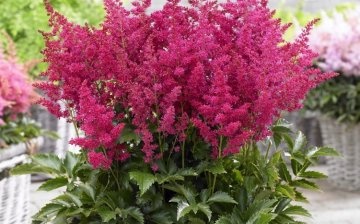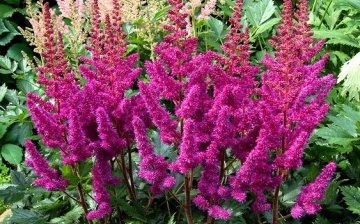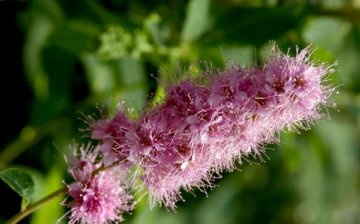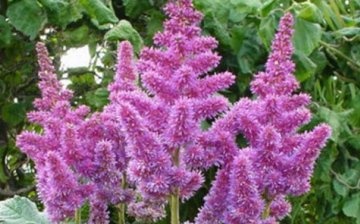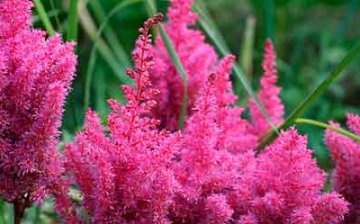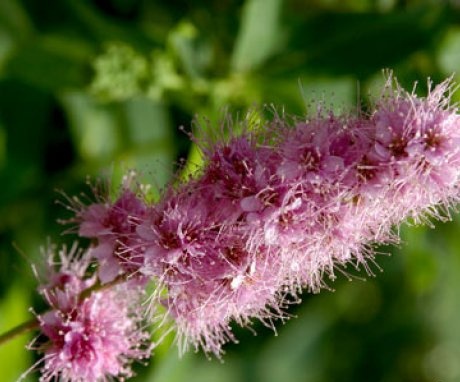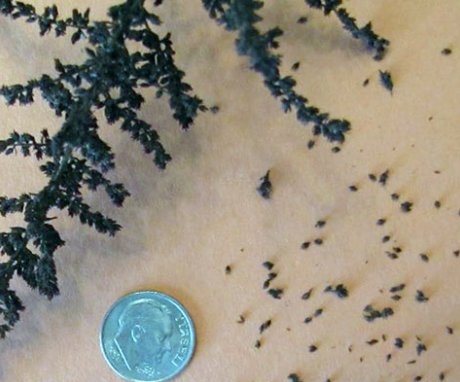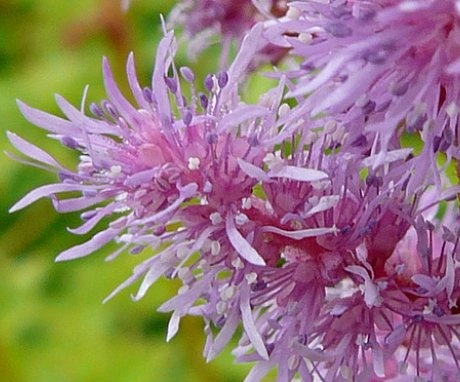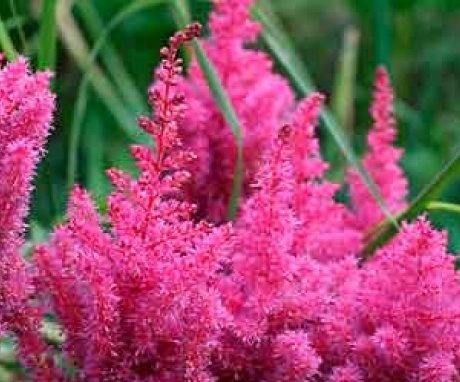Astilba - simple growing of a flower from seed
Astilba is a herbal plant that came to our region from East Asia and North America. There are forty varieties of this plant in the wild.
Contents:
- Description of astilba
- Astilba varieties
- Growing from seeds
- Sowing seeds for seedlings
- Astilba transplant
- Astilba care
Description of astilba
Height astilbe it can be up to a meter, and the color of the petals ranges from red to purple. This plant is long-lived and unpretentious. It is perfect for summer cottages and plots outside the city. For ten years, the flower can grow in the same place, like the seeds of a girl's grape. In addition, the plant looks very impressive.
This plant is really beautiful. Its lush bushes are shrouded in a large cloud of flowers, they thrive in the shade and get along well with plants.
The shapes of the inflorescences differ by varieties and can be:
- Paniculate
- Rhombic
- Drooping
- Pyramidal
Astilba is widely used in the design of gardens and landscape design... You can use it as a fence when decorating lush flower beds and small flower beds. Hosts will be wonderful plant neighbors in the shady corners of a large garden, and daylilies will look great in the sun.
The best conditions for the development of astilba are partial shade.
Just do not place the flower next to the trees, as their roots will negatively affect the growth of the flower. In some varieties, in places exposed to sunlight, flowering will increase, but its duration will be reduced. And some varieties, on the contrary, will bloom worse in the shade.
Astilbe bloom begins in early summer. Late varieties can bloom until September. If there are different varieties in the flower garden, then its beauty will be maintained for a fairly long period of time.
Astilba varieties
The types of astilba are diverse. Alas, choosing material for sowing, it is not always possible and necessary to rely on the photograph on the package. There are several species that have gained particular popularity among flower growers, their parameters, color and flowering time are described below.
The most popular varieties of astilba:
- Arends Astilba represents perennial, a bush of pyramidal or spherical shape, reaches a meter in height. The color of the leaves is a dark, tall peduncle topped with purple and snow-white, scarlet and pinkish flowers.
- Chinese astilbe. This plant is also perennial. It can be small or large. Reddish hairs give the leaves a bronze tint. Dense inflorescences reach a length of thirty centimeters, inflorescences are crowned with small flowers of lilac, pinkish and snow-white flowers. This variety blooms from early to late summer.
- Japanese astilbe. A round bush will not grow more than eighty centimeters in height. Leaves are bright green, shiny. Inflorescences resemble panicles in shape, reaching thirty centimeters in length. There are snow-white and pink colors. Already in June, this variety begins to open its buds.
- Common astilbe does not grow more than half a meter in height. It can be how to arrange flower bed, and grow in a container, since astilba is very compact. The variety begins to bloom in early June.Inflorescences are loose, the color range is limited to pink, white and coral flowers.
- Astilba David. The bush is large enough, sometimes up to one and a half meters in height. Leaves are light in color, but with dark veins. The shades of the buds are red and purple. It blooms magnificently from July to August.
Growing from seeds
This procedure can be carried out in only three ways: dividing the bush, seeds and kidneys.
Reproduction by dividing the bush:
- To do this, in early spring, you need to dig up the plant, remove the leaves and dead roots.
- Then you need to divide the bush into two lobes, each must contain at least three buds.
- Planting material must be planted at least thirty centimeters apart.
- You need to look after by watering every day seedlings.
- Astilbe planted in this way will bloom by August. This procedure should be carried out in the summer if you want to rejuvenate the bush.
Reproduction by buds is a longer way. It is necessary to cut off the shoots in early spring along with a part of the rhizome, treat the cuts with ash. Root the cut shoots in a mixture of peat and gravel under a polyethylene film.
Plants can be planted in a permanent place no earlier than one year later.
The seeds that you grow in your garden cannot keep the characteristics of the variety. This method of cultivation can only be practiced with artificially selected species. Shop the seeds will become the most acceptable option. It is very interesting to grow a plant in this way, since the development of a large plant from a small seed is amazing.
Growing from seed:
- Growing the plant is best in light soil, but heavy loamy soil is also good.
- The plant will bloom later, but the flowering time will increase.
- Prepare the beds in advance. Delete weeds, the remnants of roots, add peat, compost or humus to the soil.
- In order for the bush to subsequently acquire a beautiful shape, you need to make a bed at least one meter long.
- Landing pits should not be more than thirty centimeters deep.
- The top layer of the earth must be fertile, so you need to apply complex fertilizers and bone meal directly to the pits, which will provide a sufficient amount of phosphorus and potassium.
Sowing seeds for seedlings
The seed of this flower is a must stratify... You need to start doing this in February. In one month, you need to create conditions in the apartment close to natural conditions in which they winter the seeds plants. This procedure will greatly increase seed germination.
Mix peat and sand in equal parts in a wide container, and on top lay a thin layer (1 cm) of snow on which you want to put the seeds. The snow will melt and the seeds will begin to sink into the moist ground. When the seeds completely in the ground, place the container in a cold place. After three weeks, transfer the container to a lighted and warm place.
You can grow seedlings immediately after stratification.
The earth should not dry out, but it should not be too wet either. A spray bottle or a spray bottle will be the perfect tool for watering the sprouts. After the first shoots appear, carefully water them with a syringe under the root. Dive, pinching off one third of the root, seedling, after two true leaves appear. At the end of spring, more or less stronger seedlings can be planted in the garden. It is better to plant in the shade.
Astilba transplant
Let be astilba and a perennial plant, but it still needs a transplant. Time passes, the roots look to the surface and begin to dry out. This condition of the plant is the main reason for not very good appearance and noticeably poor flowering. The flowers become smaller and the number of peduncles decreases.
Transplant astilbe every four years to keep it looking good.
With a sharp tool, divide the bush so that developed buds remain in each part, deepen them when planting three centimeters into the ground. Feed the young bushes with complex fertilizers or humus, water, after watering, mulch the pit with peat.
In the first year, you need to remove all peduncles, as they weaken the plant. You can transplant less often, provided that you constantly add fertile soil to the roots of the plant.
Astilba care
Care behind these plant is simple enough:
- The flower is very fond of water, but droughts have an extremely detrimental effect on it.
- Astilba can live 10 years with the right regimen top dressing.
- Trim wilted buds.
- The plant is fairly resistant to frost, but still requires proper care during cold weather.
- Plants are needed as often as possible to water, since if the soil dries up, the leaves will wither, and the inflorescences will become smaller. It is especially worthwhile to monitor the irrigation regime during the period when flower stalks are formed (August - September)
- Make mineral fertilizers into moist soil, in which case they will bring more benefits. When the soil is dry, the plant can be composted. Fertilize astilba at least twice a year. If you mulch and loosen the soil during top dressing, the effect of top dressing will be longer.
- Do not rush to cut the flower stalks immediately after the plant has bloomed, because even when dried, they will decorate the garden. But still, at the end of the season, when it’s time to put the garden in order, you need to cut the stems flush with the ground, and the place where the astilbe grew should be mulched. If before that you transplanted the plant, then throwing spruce branches on the rhizomes of the newly planted bushes will not be superfluous. This will protect the plants from frost, and you can be sure that in the spring the flower will bloom its beautiful buds again.
More information can be found in the video.



